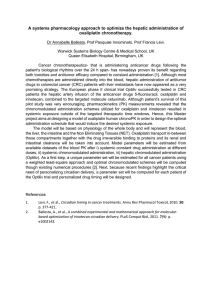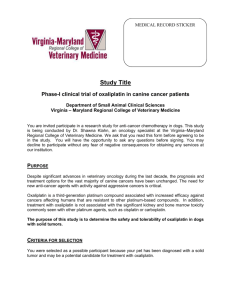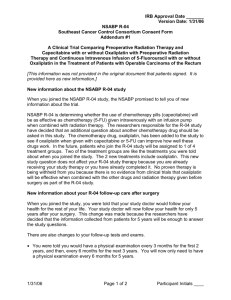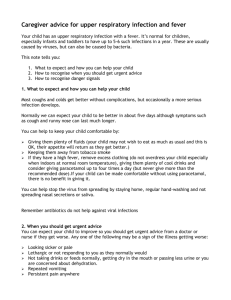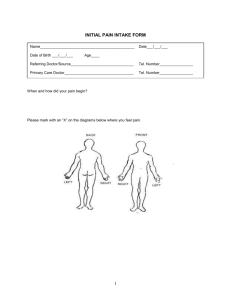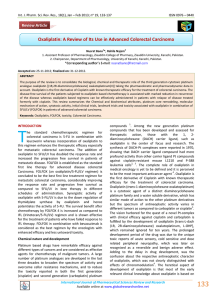Oxaliplatin Patient Handout
advertisement
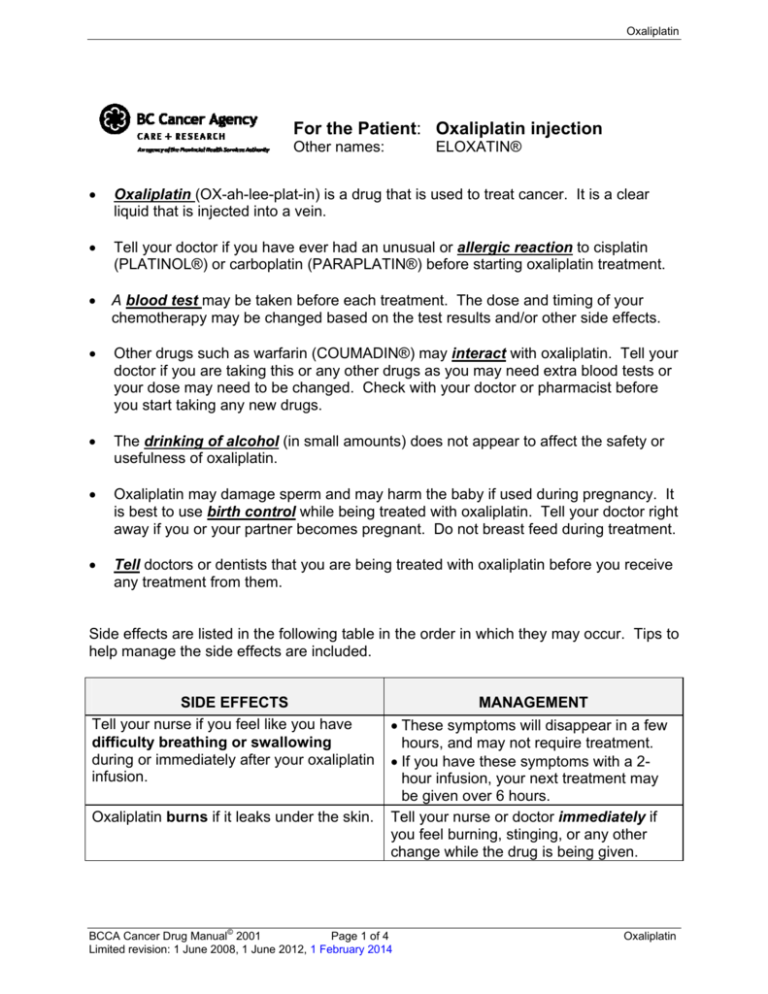
Oxaliplatin For the Patient: Oxaliplatin injection Other names: ELOXATIN® • Oxaliplatin (OX-ah-lee-plat-in) is a drug that is used to treat cancer. It is a clear liquid that is injected into a vein. • Tell your doctor if you have ever had an unusual or allergic reaction to cisplatin (PLATINOL®) or carboplatin (PARAPLATIN®) before starting oxaliplatin treatment. • A blood test may be taken before each treatment. The dose and timing of your chemotherapy may be changed based on the test results and/or other side effects. • Other drugs such as warfarin (COUMADIN®) may interact with oxaliplatin. Tell your doctor if you are taking this or any other drugs as you may need extra blood tests or your dose may need to be changed. Check with your doctor or pharmacist before you start taking any new drugs. • The drinking of alcohol (in small amounts) does not appear to affect the safety or usefulness of oxaliplatin. • Oxaliplatin may damage sperm and may harm the baby if used during pregnancy. It is best to use birth control while being treated with oxaliplatin. Tell your doctor right away if you or your partner becomes pregnant. Do not breast feed during treatment. • Tell doctors or dentists that you are being treated with oxaliplatin before you receive any treatment from them. Side effects are listed in the following table in the order in which they may occur. Tips to help manage the side effects are included. SIDE EFFECTS Tell your nurse if you feel like you have difficulty breathing or swallowing during or immediately after your oxaliplatin infusion. Oxaliplatin burns if it leaks under the skin. MANAGEMENT • These symptoms will disappear in a few hours, and may not require treatment. • If you have these symptoms with a 2hour infusion, your next treatment may be given over 6 hours. Tell your nurse or doctor immediately if you feel burning, stinging, or any other change while the drug is being given. BCCA Cancer Drug Manual© 2001 Page 1 of 4 Limited revision: 1 June 2008, 1 June 2012, 1 February 2014 Oxaliplatin Oxaliplatin SIDE EFFECTS Nausea and vomiting may occur after your treatment and may last for 24-48 hours. Some people have little or no nausea. Pain or tenderness may occur where the needle was placed. Fever may occur shortly after treatment with oxaliplatin. Fever should last no longer than 24 hours. Diarrhea may occur. Your white blood cells will decrease 1-2 weeks after your treatment. They usually return to normal 3 weeks after your last treatment. White blood cells protect your body by fighting bacteria (germs) that cause infection. When they are low, you are at greater risk of having an infection. MANAGEMENT You may be given a prescription for an antinausea drug(s) to take before your chemotherapy treatment and/or at home. It is easier to prevent nausea than treat it once it has occurred, so follow directions closely. • Eat and drink often in small amounts. • Try the ideas in Food Choices to Help Control Nausea.* Apply warm compresses or soak in warm water for 15-20 minutes several times a day. • Take acetaminophen (e.g., TYLENOL®) every 3-4 hours. • Fever which occurs more than 48 hours after treatment may be the sign of an infection. See details below. If diarrhea is a problem: • Drink plenty of liquids. • Eat and drink often in small amounts. • Eat low fibre foods such as cheese, rice, pasta, white bread, juices, meat, eggs. • Avoid high fibre foods such as bran, whole grain breads and cereals, nuts, fruits and vegetables. To help prevent infection: • Wash your hands often and always after using the bathroom. • Take care of your skin and mouth. • Avoid crowds and people who are sick. • Call your doctor immediately at the first sign of an infection such as fever (over 100°F or 38°C by an oral thermometer), chills, cough, or burning when you pass urine. BCCA Cancer Drug Manual© 2001 Page 2 of 4 Limited revision: 1 June 2008, 1 June 2012, 1 February 2014 Oxaliplatin Oxaliplatin SIDE EFFECTS Your platelets may decrease 1-2 weeks after your treatment. They usually return to normal 3 weeks after your last treatment. Platelets help to make your blood clot when you hurt yourself. You may bruise or bleed more easily than usual. MANAGEMENT To help prevent bleeding problems: • Try not to bruise, cut, or burn yourself. • Clean your nose by blowing gently. Do not pick your nose. • Avoid constipation. • Brush your teeth gently with a soft toothbrush as your gums may bleed more easily. Maintain good oral hygiene. Some medications such as ASA (e.g., ASPIRIN®) or ibuprofen (e.g., ADVIL®) may increase your risk of bleeding. • Do not stop taking any medication that has been prescribed by your doctor (e.g., ASA for your heart). • For minor pain, try acetaminophen (e.g., TYLENOL®) first, to a maximum of 4 g (4000 mg) per day, but occasional use of ibuprofen may be acceptable. You may feel tingling or a loss of feeling • Avoid cold air if possible. in your hands, feet, nose, or throat. • Protect yourself from the cold, which can They may be made worse by exposure to cause or worsen these symptoms. Wear cold. These problems often disappear gloves, socks, and something that after a few hours or days. covers your mouth and nose when outside in cold weather. • Do not drink cold beverages or eat cold food for a few days after treatment. • If symptoms continue for more than a week, or interfere with how your hands work, talk to your doctor. • Try the ideas in Coping With / Preventing Oxaliplatin Cold Dysesthesias.* Tiredness and lack of energy may occur. • Do not drive a car or operate machinery if you are feeling tired. • Try the ideas in Your Bank to Energy Savings: Helping People with Cancer Handle Fatigue.* If hair loss is a problem, refer to For the Patient: Hair Loss Due to Chemotherapy.* Hair loss is rare with oxaliplatin. Your hair will grow back once you stop treatment with oxaliplatin. Colour and texture may change. *Please ask your chemotherapy nurse or pharmacist for a copy. BCCA Cancer Drug Manual© 2001 Page 3 of 4 Limited revision: 1 June 2008, 1 June 2012, 1 February 2014 Oxaliplatin Oxaliplatin SEE YOUR DOCTOR OR GET EMERGENCY HELP IMMEDIATELY IF YOU HAVE: • Signs of an infection such as fever (over 100°F or 38°C by an oral thermometer); chills; cough; pain or burning when you pass urine. • Signs of bleeding problems such as black, tarry stools; blood in urine; pinpoint red spots on skin. • Signs of an allergic reaction (rare) soon after a treatment including dizziness, fast heart beat, face swelling, or breathing problems. • Seizures or loss of consciousness with or without confusion, headache, or changes in eyesight. SEE YOUR DOCTOR AS SOON AS POSSIBLE (DURING OFFICE HOURS) IF YOU HAVE: • Signs of anemia such as unusual tiredness or weakness. • Signs of liver problems such as yellow eyes or skin, white or clay-coloured stools. CHECK WITH YOUR DOCTOR IF ANY OF THE FOLLOWING CONTINUE OR BOTHER YOU: • Uncontrolled nausea, vomiting, or diarrhea. • Easy bruising or minor bleeding. • Tingling or a loss of feeling in your hands, feet, nose, or throat. • Redness, swelling, pain or sores where the needle was placed. • Redness, swelling, pain or sores on your lips, tongue, mouth or throat. REPORT ADDITIONAL PROBLEMS TO YOUR DOCTOR BCCA Cancer Drug Manual© 2001 Page 4 of 4 Limited revision: 1 June 2008, 1 June 2012, 1 February 2014 Oxaliplatin
